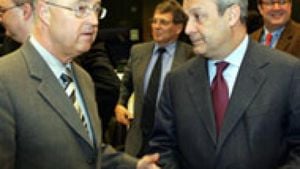The PGE Narodowy Stadium is gearing up for significant changes as the Polish national football team prepares to face Lithuania and Malta this March. The introduction of organized cheering on the stands marks the beginning of what officials hope will be a revitalized atmosphere for the team.
On February 6, Cezary Kulesza, the president of the Polish Football Association (PZPN), announced the launch of this initiative through his social media platforms. “We are implementing organized cheering at home matches for the Polish national team! I already tasked the relevant departments within PZPN to take action on this matter early this year. Today we invited representatives of the supporters’ association 'To My Polacy' to our federation’s office,” Kulesza shared.
This bold move is set to begin with Poland's qualifying matches for the 2026 FIFA World Cup. The first match against Lithuania is scheduled for March 21 at the PGE Narodowy, followed by another fixture against Malta just three days later.
PZPN's decision to initiate organized cheering is largely aimed at combatting the so-called "national picnic" atmosphere—which refers to the lackluster enthusiasm often seen from fans during recent matches. Kulesza has highlighted the importance of creating more spirited support through synchronized chanting and enthusiastic cheering led by designated fans.
The area particularly designated for this new cheering initiative will be Sector D15 of the stadium. “We invite all those interested in actively and loudly supporting the white-and-red to the D15 section at PGE Narodowy! See you at the Stadium!” concluded Kulesza.
This move has generated discussions among fans and analysts alike. While many celebrate the shift as necessary to energize the fan experience, some skeptics note the quick formation of the 'To My Polacy' group—founded just days before Kulesza's announcement. This raises questions about the depth of organization and long-term plans of this supporters’ group.
Regardless, the PZPN has assured fans from this group will not receive preferential treatment when it concerns ticket purchases. According to Łukasz Wachowski, the PZPN Secretary-General, all fans will be treated equally, required to adhere to the same rules. “Members of the 'To My Polacy' association must purchase their tickets independently and do not possess any privileges concerning this matter. They pay the full price, buy tickets at the same time as everyone else, and are subject to the same regulations—each individual may buy up to five tickets at one time,” said Wachowski.
To promote participation, the PZPN will clearly communicate to fans the presence of organized support activities planned for Sector D15, aiming to create excitement and engagement among attendees.
The PGE Narodowy, which has been home to the Polish national team for years, boasts the ability to accommodate over 58,000 attendees. It has witnessed various historic matches, including the memorable victory over Germany during the Euro 2016 qualifiers, which is imprinted deeply within the memories of Polish football fans.
Recently, discussions have also arisen about the management of national matches and potential venues. The PZPN had been deliberative concerning financial terms with the stadium's management, resulting previously in speculation about relocating matches to other venues, such as the Stadion Śląski.
Now, with the announcement of the divided scheduling of national games—two to be held at PGE Narodowy and others at Stadion Śląski—the immediate concern is set on March’s upcoming matches and their atmosphere.
Among various opinions voiced, Minister of Sport and Tourism Sławomir Nitras emphasized the importance of retaining PGE Narodowy as the national team’s home, yet recognizing the need for games to be played at other stadiums across Poland to leverage the significant infrastructure developed since Euro 2012.
“I believe the majority of fans agree with this view: PGE Narodowy should serve as home to the national team, yet all five major stadiums should regularly welcome the team,” said Nitras. He acknowledges both the significance of PGE Narodowy as a key venue and the history surrounding Polish football.
Alongside exciting developments surrounding the matches, fans look forward to witnessing how these changes will manifest during the games this March. Whether the organized cheering can effectively galvanize support remains to be seen, yet the potential for increased energy and enthusiasm could revitalise the experience for everyone involved.
Therefore, as Poland strives for success on the pitch, the atmosphere off it at the PGE Narodowy will be equally influential. Fans and players alike hope these changes lead to not just louder voices but also to victorious outcomes on the international stage.



